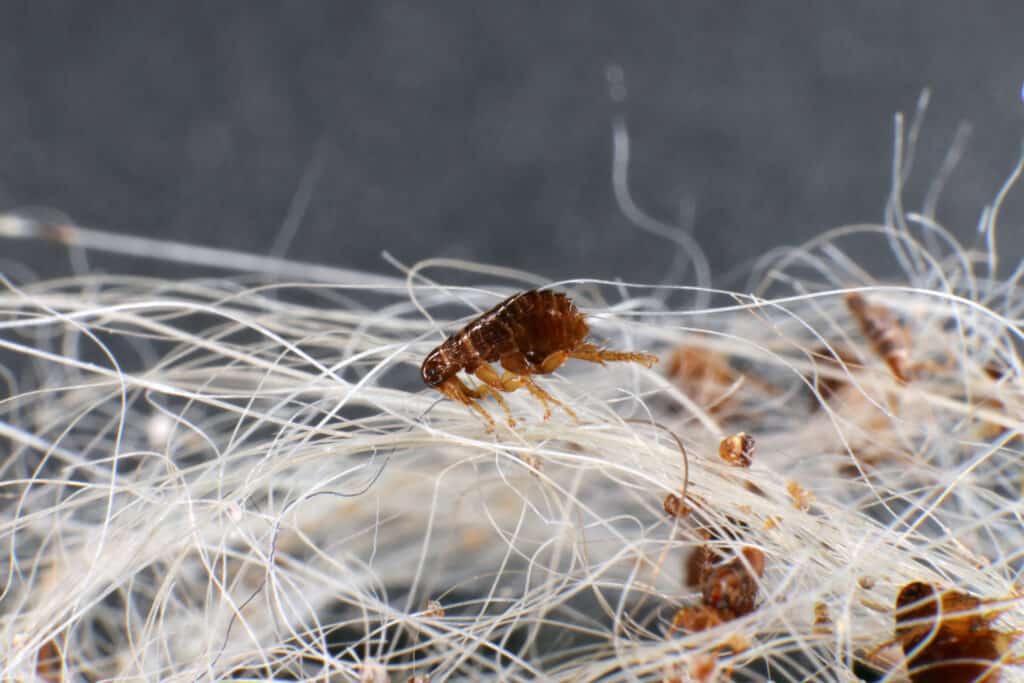An array of parasites exist in the world around us. These tiny critters rely on a host to survive, and many of them make a home out of our canine friends. These common parasites in dogs can cause serious illness in our beloved pups. For the benefit of our furry friends, it’s important to have an understanding of these parasites and their symptoms.
Parasites can live everywhere from the inside of the digestive tract to the surface of the skin. Let’s dive into some of the most common parasites seen in dogs, as well as the health complications they cause.
What Are Parasites in Dogs?

There are many forms of parasites that use our canine friends as a host.
©In Green/Shutterstock.com
A parasite is a type of organism that requires a host to complete its life cycle. The parasite will choose a host to live on or inside of, and it will typically cause some type of harm to their host. There are many types of parasites that impact different parts of the body, and most of them can seriously impact a dog’s health if they are not eliminated.
Endoparasites vs. Ectoparasites in Dogs
There are two main categories of parasties to keep in mind: endoparasites and ectoparasites. Endoparasites live inside of their host, while ectoparasites live on the surface of their host. To help you gain a better understanding of the two types, we’ll offer examples that you can refer to!
Endoparasites: Intestinal parasites like roundworms, hookworms, and other worms that inhabit the digestive tract.
Ectoparasites: Critters that live on the surface of your dog’s skin like fleas, ticks, and skin mites.

Roundworms are often responsible for that pot-bellied or bloated appearance you see in many worm-infected puppies.
©iStock.com/Michael Edwards
Roundworms in Dogs
Roundworms are one of the most common parasites in our canine friends. These worms are often the ones responsible for that pot-bellied or bloated appearance you see in many worm-infected puppies. Our dogs can become infected by eating infected stool, digging in infected soil, or consuming infected soil. They can also contract it from their mothers. If a mother dog has roundworms, she can pass it to her puppies in the uterus or though infected milk.
The most common symptoms of roundworms include loose or bloody stool, diarrhea, gas, and long worms in their stool. They may also experience bloating, vomiting, appetite changes, and weight loss. The only way to treat roundworms is with a prescription strength deworming medication from your vet. We suggest reaching out to your veterinary team if you think your pup could have roundworms.
Tapeworms in Dogs
Along with roundworms, tapeworms are one of the most commonly diagnosed intestinal parasites in dogs. Tapeworms are unlike other intestinal parasites. Dogs can only acquire them by ingesting infected fleas. This means that a dog typically needs to have had fleas at some point to be infected with tapeworms. However, all it takes is one infected flea to expose a dog. Once he eats this infected flea, the tapeworm will then continue its life cycle within the dog’s digestive tract.
The most common sign of tapeworms is rice-like worms in the poop, but there are other symptoms as well. These include loose stool, diarrhea, gas, weight loss, vomiting, and a dull coat. If you think your pup could have tapeworms, have him seen by a vet for proper treatment.
Hookworms in Dogs
The next common intestinal parasite on the list is the hookworm. Though hookworms aren’t common in our canine companions, they are one of the most dangerous parasites on our list. Not only does the hookworm cause severe GI upset, but they have one dangerous trick up their sleeve: they drink your dog’s blood. The hookworm feeds on the blood vessels within a dog’s digestive tract. This can lead to life-threatening anemia if the worms are not treated in a timely manner.
Dogs can become infected with hookworms by digging in infected soil, eating infected stool, and from their infected mother. Hookworms can cause diarrhea and vomiting, but infected pups can also develop more serious health complications. Hookworms cause a dog to experience pale gums, lethargy, weakness, and even breathing difficulties. They can be fatal, so have your pup seen by your vet ASAP if she experiences any of these symptoms.
Giardia & Coccidia in Dogs
Though still considered intestinal parasites, both coccidia and giardia are not worms like the other GI parasites on this list. Both coccidia and giardia are single-celled organisms called protozoans. They are microscopic organisms that we cannot seen with the naked eye. Dogs most often infect themselves when they eat infected stool or soil. Even drinking infected water outdoors can be dangerous.
These types do not have a worm-like body like other GI parasites, but they can still cause serious damage to a dog’s digestive tract. Both coccidia and giardia cause severe diarrhea in canines, and this can often lead to dehydration and weight loss. If your dog is experiencing GI upset that lasts for more than 48 hours, have him assessed by your vet.
Fleas In Dogs

Fleas are without a doubt the most common ectoparasite on our list, and likely the most common parasite overall.
©photowind/Shutterstock.com
Now that we’ve discussed the most common endoparasites in dogs, it’s time to dive into the common ectoparasites. Fleas are without a doubt the most common ectoparasite on our list, and likely the most common parasite overall. These tiny bugs live on the surface of a dog’s skin, and they rely on blood to survive. Each flea bite can lead to serious skin irritation in dogs. They also cause uncomfortable skin-crawling sensations for our furry buddies.
Most dogs come in contact with fleas in the grass outside, but they can also catch fleas from close contact with other infected dogs. Fleas are also a vector for tapeworms and flea-borne illness. If you see fleas on your canine’s skin, reach out to your vet for flea treatment. Additionally, all dogs should be on a flea preventative.
Ticks in Dogs
Ticks are yet another ectoparasite that rely on sucking blood to survive. There are many different types of ticks that exist around the world, but each of them can attach themselves to a dog. These crawling critters often spend their time on grass or other vegetation. They hitch a ride on dogs that accidently brush up against them. Ticks range in size from barely visible to the diameter of a small grape. So, it’s important to examine your dog’s body closely.
Not only can ticks suck your dog’s blood, but they can also transfer tick-borne illness. These conditions can be fatal, which is why you never want to let ticks spend any time on your dog. If you ever see a tick on your dog’s body, seek professional guidance before removing it. Reach out to your vet for tick treatment and prevention.
Ear Mites in Dogs
Many pet parents are unaware of the fact that our canine friends are susceptible to ear mites, an ectoparasite. These tiny critters live inside of your dog’s ear, and they often branch out to the fur surrounding their ears as well. They multiply at surprising rates inside of your pet’s ear, and lead to serious irritation of the ear canal. Not only is the presence of ear mites uncomfortable, but they can also lead to an ear infection.
The most common signs of ear mites include brown dirt in the dog’s ear, head shaking, pawing at their face, and ear odor. If you think your pup could have ear mites, reach out to your veterinarian for an approved treatment method. We suggest steering clear of any ear mite treatment or ear cleansers at pet stores, unless your vet approves them.
Mange in Dogs
The last ectoparasite on our list is mange. There are different types of manage, but the most common types seen in dogs are demodex and sarcoptic mange. Both forms of manage can lead to severe skin irritation and fur loss. However, there are a few major differences between the two.
Demodex is a skin mite that is always present on the dog’s skin, but they can multiply to a dangerous amount if the dog’s immune system is suppressed. When the normal amount of demodex multiplies to a dangerous level, patches of fur loss will begin. This occurs due to the fact that the demodex mite invades the dog’s hair follicles. Dogs with demodex may also experience itchy skin, skin redness, and dry patches of skin.
On the other hand, sarcoptic mange is the result of a foreign skin mite coming in contact with your dog’s skin. These mites burrow into the skin and wreak havoc on skin and coat health. The most common symptoms of sarcoptic mange are fur loss, itchy skin, red skin, and crusty sores. Bacterial infections, skin thickening, and even systemic illness can also occur. If you think your dog could have either form of mange, we suggest setting an appointment with your vet.
Final Thoughts
As you can see, there are unfortunately many types of parasites that are common in our beloved dogs. While these critters are often very tiny, they can lead to a large amount of damage for the dog affected. We suggest reviewing the information we covered above, and keeping an eye out for any of the symptoms we discussed. If you ever see any of these symptoms, call your vet right away!
The photo featured at the top of this post is © Andy Dean Photography/Shutterstock.com
Ready to discover the top 10 cutest dog breeds in the entire world?
How about the fastest dogs, the largest dogs and those that are -- quite frankly -- just the kindest dogs on the planet? Each day, AZ Animals sends out lists just like this to our thousands of email subscribers. And the best part? It's FREE. Join today by entering your email below.
Thank you for reading! Have some feedback for us? Contact the AZ Animals editorial team.






